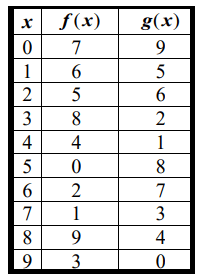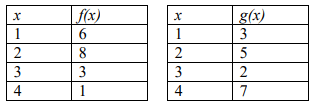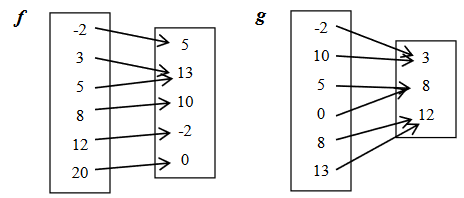EVALUATING COMPOSITION OF FUNCTIONS FROM TABLE
Subscribe to our ▶️ YouTube channel 🔴 for the latest videos, updates, and tips.
To evaluate composition of functions from table, we use the following strategies.
Evaluating (f ∘ g) (x) :
(f ∘ g) (x) = f[g(x)]
Let g(x) = t
Find the output for g(x) and apply in the first step. So, we get
(f ∘ g) (x) = f (t)
When the input is t, find the value of f(t). Let us consider f(t) = z
(f ∘ g) (x) = z
Subscribe to our ▶️ YouTube channel 🔴 for the latest videos, updates, and tips.
Use the table of values to evaluate each expression

Problem 1 :
Find (f ∘ g) (8)
Solution :
(f ∘ g) (8) = f[g(8)]
When input = 8, the output g(8) is 4
= f[4]
When input = 4, the output f(4) is 4
(f ∘ g) (8) = 4
Problem 2 :
Find (f ∘ g) ( (5))
Solution :
(f ∘ g) (5) = f[g(5)]
When input = 5, the output g(5) is 8
= f[8]
When input = 8, the output f(8) is 9.
(f ∘ g) (5) = 9
Problem 3 :
Find (g ∘ f) (5)
Solution :
(g ∘ f) (5) = g[f(5)]
When input = 5, the value of f(5) = 0
= g[0]
When input = 0, the value of g(0) = 9
= 9
Problem 4 :
Evaluate (g ∘ f) ( (3))
Solution :
(g ∘ f) (3)
When input = 3, the value of f(3) = 8
= g[8]
When input = 0, the value of g(8) = 4
= 4
Problem 5 :
Evaluate (f ∘ f) (4)
Solution :
(f ∘ f) (4)
When input = 4, the value of f(4) = 4
= f[4]
When input = 4, the value of f(4) = 4
= 4
Problem 6 :
Evaluate (f ∘ f) (1)
Solution :
(f ∘ f) (1)
When input = 1, the value of f(1) = 6
= f[6]
When input = 6, the value of f(6) = 2
= 2
Problem 7 :
Evaluate (g ∘ g) (2)
Solution :
(g ∘ g) (2) = g[g(2)]
When input = 2, the value of g(2) = 6
= g[6]
When input = 6, the value of g(6) = 7
= 7
Problem 8 :
Evaluate (g ∘ g) (6)
Solution :
(g ∘ g) (6) = g[g(6)]
When input = 6, the value of g(6) = 7
= g[7]
When input = 7, the value of g(7) = 3
= 3
Problem 9 :
Using the tables below, evaluate (f ∘ g)(3) and (g ∘ f) (4)

Solution :
i) (f ∘ g)(3) = f[g(3)]
When x = 3, the output for g(3) will be 2.
= f(2)
When x = 2, the output for f(2) will be 8.
(f ∘ g)(3) = 8
ii) (g ∘ f) (4) = g[f(4)]
When x = 4, the output for f(4) will be 1.
= g (1)
When x = 1, the output for g(1) will be 3.
(g ∘ f) (4) = 3
Problem 10 :
Given
f(2) = 3, f(3) = 4, f(5) = 0, g(2) = 5, g(3) = 2, and g(4) = -1,
evaluate the following.
a) f(g(3)) b) f(g(2)) c) g(f(2)) d) g(f(3))
Solution :
From the given inputs and outputs, we can create a table.
|
x |
f(x) |
x |
g(x) |
|
2 3 5 |
3 4 0 |
2 3 4 |
5 2 -1 |
a) f(g(3)) = f(2) ==> 3
b) f(g(2)) = f(5) ==> 0
c) g(f(2)) = g(3) ==> 2
d) g(f(3)) = g(4) ==> -1
Problem 11 :
Let
f = {(1, 5), (2, 6), (3, 7)} and g = {(5, 10), (6, 11), (7, 0)}.
Explain how each equation is true.
a) g(f(1)) = 10 b) g(f(3)) = 0
Solution :
a) g(f(1)) = 10
In f(1), when input = 1, the output = 5
g(f(1)) = g(5)
= 10
So, a is true.
b) g(f(3)) = 0
In f(3), when input = 3, the output = 7
g(f(3)) = g(7)
= 0
So, b is true.
Problem 12 :
Use the arrow mappings to find the following

a) (f ∘ g) (10)
b) (g ∘ f) (-2)
c) (g ∘ f) (6)
d) f[g(f(20)]
e) f [ g(g(0)) ]
Solution :
a) (f ∘ g) (10) = f[g(10)] = f(3) ==> 13
b) (g ∘ f) (-2) = g[f(-2)] = g(5) ==> 8
c) (g ∘ f) (6) = g[f(6)]
Since f(6) is undefined, (g ∘ f) (6) = undefined.
d) f[g(f(20)]
The value of f(20) = 0
f[g(f(20)] = f[g(0)]
The value of g(0) = 8
f[g(0)] = f(8)
The value of f(8) is 10.
f[g(f(20)] = 10
e) f [ g(g(0)) ]
The value of g (0) = 8
f[g(g(0)] = f[g(8)]
The value of g(8) = 10
f[g(8)] = f(10)
= undefined
Recent Articles
-
Finding Range of Values Inequality Problems
May 21, 24 08:51 PM
Finding Range of Values Inequality Problems -
Solving Two Step Inequality Word Problems
May 21, 24 08:51 AM
Solving Two Step Inequality Word Problems -
Exponential Function Context and Data Modeling
May 20, 24 10:45 PM
Exponential Function Context and Data Modeling